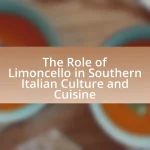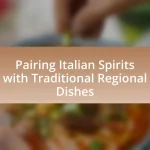Italian street foods are quick, flavorful dishes sold by vendors throughout urban Italy, showcasing regional ingredients and culinary traditions. This article explores the characteristics of popular street foods such as pizza al taglio, arancini, and panzerotti, highlighting their differences from traditional Italian cuisine. It also examines the cultural significance of beverage pairings with these foods, offering insights into ideal matches that enhance the overall dining experience. Additionally, the article provides tips for creating the perfect street food and beverage experience, emphasizing the importance of flavor profiles and balance in pairings.
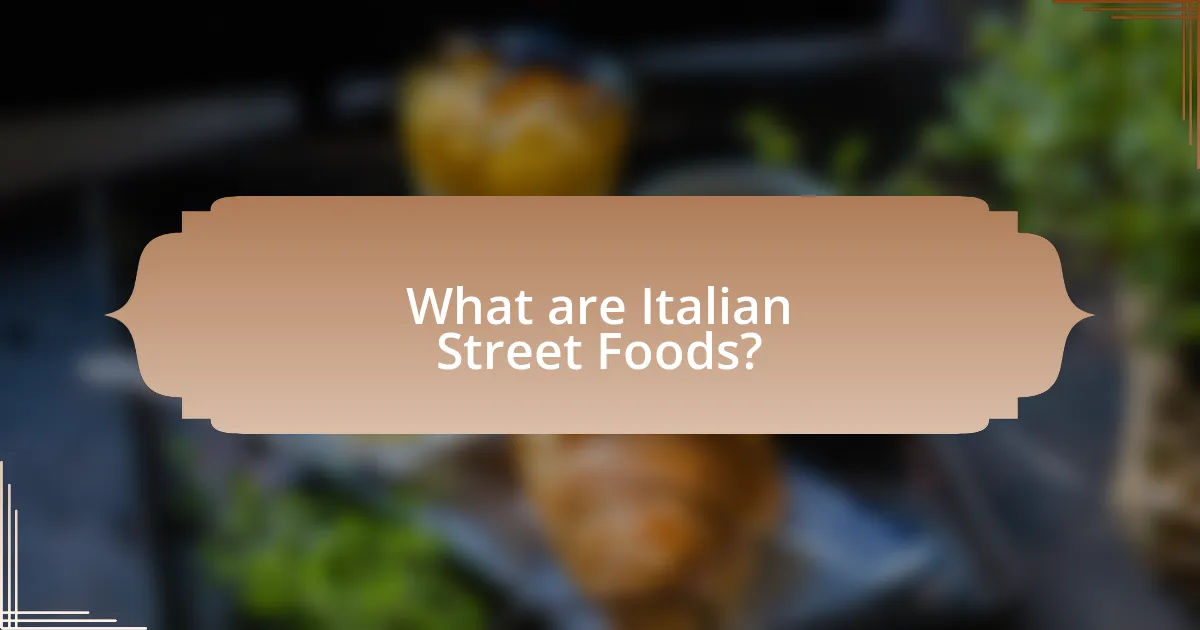
What are Italian Street Foods?
Italian street foods are quick, flavorful dishes typically sold by vendors in urban areas across Italy. Common examples include pizza al taglio (sliced pizza), arancini (fried rice balls), and panini (grilled sandwiches). These foods often reflect regional ingredients and culinary traditions, making them a vibrant part of Italian culture. For instance, in Sicily, arancini are filled with ragù, while in Rome, supplì (fried rice balls) are often filled with mozzarella. The popularity of these street foods is evidenced by their presence in local festivals and markets, showcasing Italy’s rich gastronomic heritage.
How do Italian street foods differ from traditional Italian cuisine?
Italian street foods differ from traditional Italian cuisine primarily in their preparation, presentation, and consumption context. Street foods are typically designed for quick, on-the-go eating, often featuring simpler, more portable dishes like arancini, panzerotti, and pizza al taglio, which can be consumed without formal dining settings. In contrast, traditional Italian cuisine emphasizes elaborate recipes, multi-course meals, and dining experiences that highlight regional ingredients and culinary techniques. For example, while a traditional Italian meal may include multiple courses such as antipasti, primi, secondi, and dolci, street food focuses on single, easily accessible items that reflect local flavors and ingredients, catering to a fast-paced lifestyle.
What are the key characteristics of Italian street foods?
Italian street foods are characterized by their simplicity, freshness, and regional diversity. These foods often feature high-quality, locally sourced ingredients, reflecting the culinary traditions of specific areas in Italy. For example, pizza al taglio from Rome is known for its thick crust and variety of toppings, while arancini from Sicily are stuffed rice balls that are crispy on the outside and flavorful on the inside. Additionally, Italian street foods are typically served in convenient, portable formats, making them easy to eat on the go, which aligns with the vibrant street culture found in Italian cities.
Why are street foods popular in Italy?
Street foods are popular in Italy due to their convenience, cultural significance, and diverse flavors. Italians often enjoy street food as a quick and accessible meal option, reflecting the country’s culinary heritage. For example, iconic street foods like pizza al taglio and arancini are deeply rooted in regional traditions, showcasing local ingredients and recipes. The vibrant street food scene also fosters social interaction, as people gather at food stalls and markets, enhancing the communal dining experience.
What are some popular types of Italian street foods?
Popular types of Italian street foods include pizza al taglio, arancini, and panzerotti. Pizza al taglio is a rectangular, thick-crust pizza sold by the slice, originating from Rome and known for its variety of toppings. Arancini are fried rice balls filled with ingredients like meat or cheese, commonly found in Sicily and often served as a snack. Panzerotti are small, stuffed pastries, typically filled with tomato and mozzarella, originating from Puglia. These foods are integral to Italian culinary culture, reflecting regional flavors and traditions.
What is the history behind each type of street food?
The history of street food varies significantly by type, reflecting local cultures and culinary traditions. For example, pizza originated in Naples in the 18th century as a simple dish for the working class, evolving into a global favorite. Similarly, gelato has roots in ancient Italy, with its modern form developing in the Renaissance, becoming a popular street treat. Arancini, or stuffed rice balls, trace back to Sicily, where they were created as a way to use leftover risotto, showcasing resourcefulness in Italian cooking. Each type of street food not only represents regional flavors but also embodies historical practices and social customs, making them integral to Italy’s culinary heritage.
How are these street foods prepared and served?
Italian street foods are typically prepared using traditional cooking methods that emphasize fresh ingredients and regional flavors. For example, pizza al taglio is baked in large rectangular trays and served in slices, while arancini are made by forming risotto into balls, coating them in breadcrumbs, and deep-frying until golden. These foods are often served in casual settings, such as food stalls or markets, where they can be enjoyed on-the-go, highlighting the convenience and accessibility of street food culture in Italy.
What role do beverages play in the enjoyment of Italian street foods?
Beverages significantly enhance the enjoyment of Italian street foods by complementing flavors and providing balance. For instance, pairing a rich, savory arancini with a crisp white wine like Pinot Grigio elevates the dish’s taste profile, while a refreshing spritz can cut through the richness of fried foods. Studies show that the right beverage pairing can enhance the overall sensory experience, making flavors more pronounced and enjoyable. This synergy between food and drink is a cornerstone of Italian culinary culture, where meals are often designed to be enjoyed with specific beverages, thus enriching the dining experience.
How do beverages enhance the flavors of street foods?
Beverages enhance the flavors of street foods by complementing and balancing the taste profiles of the dishes. For instance, a crisp white wine can cut through the richness of fried street foods, while a refreshing soda can provide a contrast to spicy flavors, making the overall eating experience more enjoyable. Studies show that pairing beverages with food can elevate the perception of flavors; for example, a study published in the Journal of Sensory Studies found that participants rated food as more flavorful when paired with an appropriate drink. This synergy between beverages and street foods not only enhances individual flavors but also creates a more harmonious dining experience.
What are the cultural significance of pairing beverages with street foods?
Pairing beverages with street foods holds significant cultural importance as it enhances the overall dining experience and reflects regional traditions. In Italy, for example, the combination of specific wines or soft drinks with street foods like arancini or pizza al taglio showcases local flavors and culinary heritage. This practice not only elevates the taste but also fosters social interactions, as sharing food and drink is a communal activity deeply rooted in Italian culture. Furthermore, studies indicate that such pairings can influence consumer preferences and perceptions, reinforcing the cultural identity associated with specific food and beverage combinations.
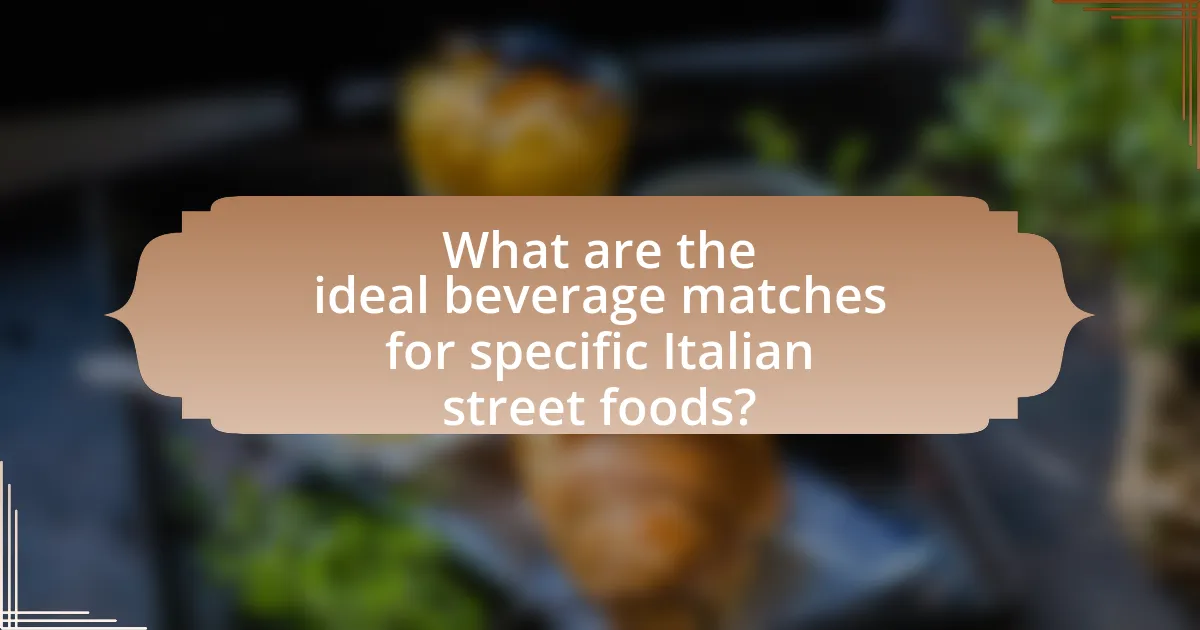
What are the ideal beverage matches for specific Italian street foods?
The ideal beverage matches for specific Italian street foods include wine, beer, and soft drinks tailored to enhance the flavors of the dishes. For example, a classic pairing is Neapolitan pizza with a light lager or a crisp white wine like Pinot Grigio, which complements the tomato and mozzarella. Arancini, or fried rice balls, pair well with a dry rosé, as its acidity balances the richness of the dish. For a savory panino, a robust red wine such as Chianti enhances the flavors of cured meats. Additionally, the sweet treat of gelato is best enjoyed with a sparkling water or a dessert wine like Moscato, which accentuates the sweetness. These pairings are rooted in regional traditions and culinary practices, ensuring a harmonious dining experience.
How can one pair beverages with popular Italian street foods?
To pair beverages with popular Italian street foods, one should consider the flavor profiles and textures of both the food and the drink. For example, pairing a classic Neapolitan pizza with a light, crisp lager enhances the dish’s savory flavors, while a robust Chianti complements the richness of a meat-filled arancini. Additionally, a refreshing spritz, made with Prosecco and Aperol, pairs well with fried calamari, balancing the dish’s oiliness. These pairings are based on traditional Italian culinary practices, where the harmony of flavors is essential for an enjoyable dining experience.
What beverages complement pizza al taglio?
Sparkling water and light-bodied red wines, such as Chianti or Frascati, complement pizza al taglio effectively. The effervescence of sparkling water cleanses the palate, while the acidity and fruitiness of light red wines enhance the flavors of the pizza toppings. Studies indicate that pairing food with beverages that have contrasting textures and flavors can elevate the overall dining experience, making these beverages ideal choices for enjoying pizza al taglio.
Which drinks go well with arancini?
Sparkling wine, particularly Prosecco, pairs well with arancini. The effervescence of Prosecco complements the rich, fried texture of arancini, enhancing the overall dining experience. Additionally, light-bodied white wines like Pinot Grigio or Sauvignon Blanc also work well, as their acidity balances the flavors of the dish. Beer, especially a crisp lager or a pale ale, can provide a refreshing contrast to the savory filling of arancini. These beverage choices are supported by culinary pairings that highlight the balance of flavors and textures in Italian cuisine.
What are the best beverages for sweet Italian street foods?
The best beverages for sweet Italian street foods include espresso, sweet dessert wines like Vin Santo, and Italian sodas. Espresso complements the rich flavors of pastries such as cannoli and tiramisu, enhancing their sweetness with its boldness. Vin Santo, a traditional dessert wine, pairs well with biscotti, as its sweetness and nutty notes elevate the flavors of the cookies. Italian sodas, often flavored with fruit syrups, provide a refreshing contrast to the sweetness of treats like gelato and zeppole, making them an ideal match.
How does coffee pair with pastries like cannoli?
Coffee pairs excellently with pastries like cannoli due to the complementary flavors and textures. The rich, creamy filling of cannoli, often made with ricotta cheese and flavored with vanilla or citrus, contrasts beautifully with the bold, slightly bitter notes of coffee. This pairing enhances the overall tasting experience, as the coffee’s acidity cuts through the sweetness of the cannoli, balancing the flavors. Additionally, the warmth of coffee can enhance the enjoyment of the pastry’s crispy shell, creating a satisfying combination.
What refreshing drinks are ideal for gelato?
Sparkling water and fruit-based beverages are ideal for pairing with gelato. Sparkling water enhances the gelato’s flavors without overpowering them, while fruit-based drinks like lemonade or fruit spritzers complement the sweetness and creaminess of gelato. These combinations are popular in Italian culture, where refreshing drinks are often enjoyed alongside desserts to balance richness.
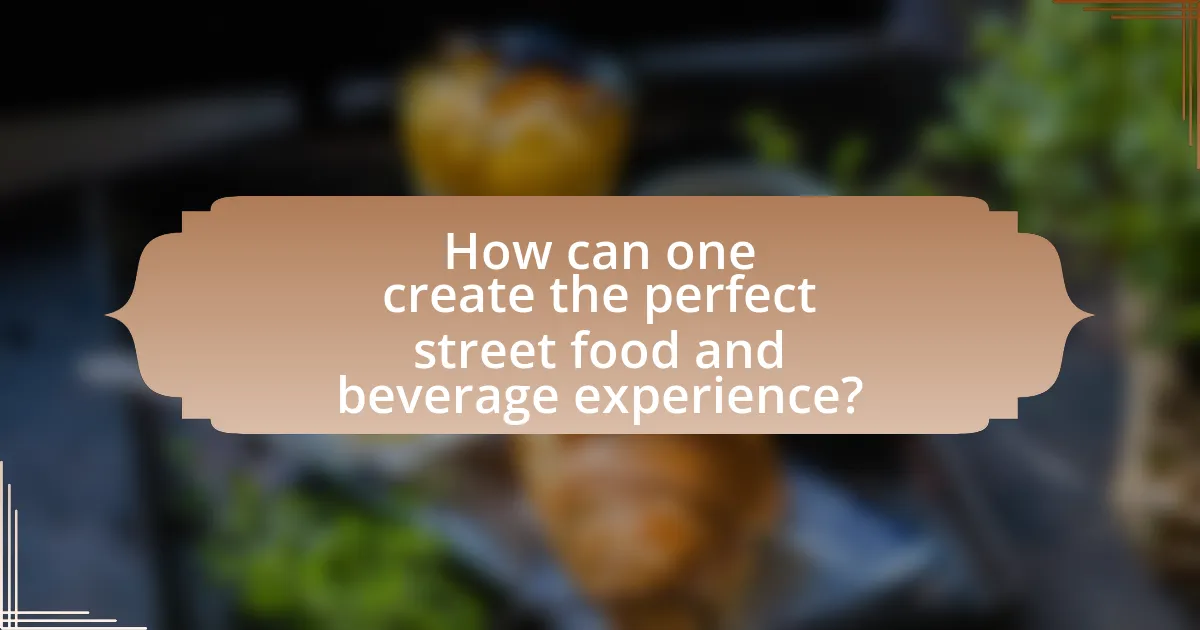
How can one create the perfect street food and beverage experience?
To create the perfect street food and beverage experience, one should focus on pairing authentic Italian street foods with complementary beverages that enhance the flavors. For instance, pairing a classic Neapolitan pizza with a crisp, refreshing Italian lager like Peroni elevates the taste, as the beer’s carbonation cuts through the richness of the cheese. Additionally, serving arancini with a light, fruity white wine such as Pinot Grigio accentuates the dish’s savory flavors. This approach is supported by culinary studies that emphasize the importance of flavor pairing in enhancing dining experiences, demonstrating that thoughtful beverage choices can significantly elevate the enjoyment of street food.
What tips can enhance the enjoyment of Italian street foods and their beverages?
To enhance the enjoyment of Italian street foods and their beverages, pairing the right drink with specific foods is essential. For example, pairing a classic Neapolitan pizza with a light, crisp lager accentuates the flavors of the dish, while a rich Chianti complements the savory notes of a hearty panini. Additionally, enjoying gelato with a shot of espresso creates a delightful contrast between the cold and warm elements, enhancing the overall experience. These pairings are rooted in Italian culinary traditions, where the balance of flavors is key to enjoying the meal fully.
How can one choose the right beverage for a street food festival?
To choose the right beverage for a street food festival, one should consider the flavor profiles of the food being served. For example, pairing a light, crisp white wine like Pinot Grigio with fried calamari enhances the dish’s flavors, while a robust red wine such as Chianti complements heartier options like meatballs. Additionally, regional beverages like Italian craft beers or sparkling water can refresh the palate between bites. This approach is supported by culinary pairing principles that suggest matching acidity and body of beverages with the food’s characteristics for an optimal tasting experience.
What are common mistakes to avoid when pairing street foods with drinks?
Common mistakes to avoid when pairing street foods with drinks include ignoring flavor profiles, mismatching acidity levels, and overlooking the intensity of flavors. Ignoring flavor profiles can lead to combinations that clash, such as pairing spicy street foods with overly sweet drinks, which can overwhelm the palate. Mismatching acidity levels, for instance, pairing a high-acid beverage with a low-acid food, can result in a lack of balance, making the food taste flat. Additionally, overlooking the intensity of flavors can cause a strong dish to overpower a delicate drink, leading to an unsatisfactory experience. These principles are essential for achieving harmonious pairings that enhance both the food and the beverage.



